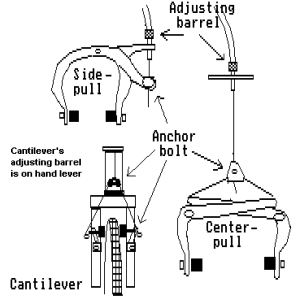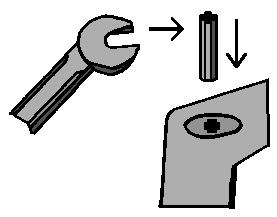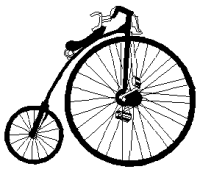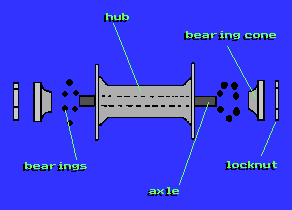Bicycle Glossary A B C D E F G H I J K L M N O P Q R S T U V W X Y Z
Bicycle Glossary - A
![]()
Adjustable bicycle wrench - An open-ended wrench which can be adjusted to fit nuts and bolts in a range of sizes. Adjustable wrenches suitable for bicycles can also be used to bend thin metal items such as chainring teeth. Most adjustable wrenches have a hole in the back end of the handle which people assume is only for hanging the wrench up. But, this hole can be put over a wrench to get more leverage to turn a stubborn bolt or to develop enough torque to bend a metal rod. The most useful size in emergency bicycle repair on the road is six-inch. The six-inch adjustable wrench is large enough to turn axle nuts, yet small enough for derailleur adjustments. In the shop, a fifteen-inch adjustable wrench is nice for bottom bracket overhaul and headset adjustment if the exact right tools are not available.
Do not use an adjustable wrench for bicycles loosely. Set the thumbwheel adjustment to tightly grab any nut or bolt which you plan to turn unless the amount of pressure you'll be using is slight. Apply the adjustable wrench all the way, so that the bolt head is deep in the jaws rather than out at the edge of the wrench. Synonym: Crescent wrench.
Adjusting barrel - A long hollow bolt through which a control cable's inner wire passes, but at which the cable casing stops. These are found on the bike's brake hand levers, at or rear brake calipers and sometimes on shifters and derailleurs. Adjusting barrels are used for fine adjustment. If they are screwed out, the cable becomes tighter.

See also: Anchor bolt
Adjusting screw - Synonym: Limit screw.
Air pressure - The amount of compression of the air in a bike tire. Almost all bicycle wheels have an air-filled tire, generally with an inner tube which is like a balloon to seal in the air. The compressed air makes the ride more efficient and comfortable. The pressure is usually measured in pounds per square inch. The average modern fat tire takes a pressure of up to 65 pounds per square inch (PSI). The average thin tire takes up to 100 pounds per square inch. The exact recommended pressure varies from one model of tire to another, and is almost always molded into the side of the tire. In Europe, another system of air pressure measurement is sometimes used called "bars" which refers to multiples of standard barometric pressure (14 pounds per square inch) Synonym: Inflation. See also: Schraeder valve, Presta valve.
Allen head - A hexagonal hole in the top of a bolt or screw into which you can put an "Allen wrench" to turn that bolt or screw. Allen head bolts are generally lighter in weight, and less prone to stripping than slotted, Phillips or male hexagonal bolt heads.
As used on bicycles, the most common sizes are five and six millimeters. Five millimeter Allen headed bolts are used to hold chainrings to the crank, seatpins and on some derailleur parts. Six millimeter bolts are used on seat clamps and handlebar stems. Synonym: Hex head
Allen bolt - A bolt or screw with an Allen head. Synonym: Hex bolt.
Allen wrench - A tool which will turn Allen bolts. The standard Allen wrench is shaped like an L. For some reason, most are flat black or dark gray in color. Variations include Y shaped tools with a differing size Allen wrench at the end of each tip, and Allen wrenches at the end of screwdriver handles. Synonym: Hex wrenches, Hex keys.

Tip: Allen wrenches for touring.
Align - To make a wheel or other rotating device, such as a chainwheel, round and on-plane.
How-to: Straightening wheels
Alloy - 1. A metal that is mixed with other metals to give it more useful properties. For instance, mixing a little nickel with steel makes an alloy that will not rust - stainless steel. 2. "Alloy" is generally used within bicycling to mean aluminum alloy, a variation of aluminum which is stronger and more malleable than pure aluminum.
Aluminum - A weak, but light metal with a whitish silvery dull shine. When alloyed with other metals, aluminum can be light and strong. See also: Alloy.
American Crank - A large steel bar bent in the shape of a dog-leg which is both cranks and bottom bracket spindle all in one piece. The ends of the bar are threaded to accept pedals. Pedals for these cranks have a smaller thread diameter than most, 1/2" instead of 9/16." American cranks are easily bent, but also easily replaced. If severely bent, they can be impossible to remove from the bottom bracket. Cut off most of the left side with a hacksaw or cutting torch. Remove the large locknut on the left side of the bottom bracket. It is left-hand threaded, so you would turn it clockwise to remove. Remove a tabbed washer, and unscrew the bearing cone you will find underneath. Remove the bearings, and you'll be able to slip the crank out. To remove the chainwheel from the American crank, hold the crank in a vise, and apply a large wrench to the bearing cone which is threaded against the chainwheel. It is conventional right-hand threading.
To reassemble, fasten the chainwheel and right bearing cone onto the crank. Install the bearings and crank into the bottom bracket. Screw the left bearing cone on, add the tabbed washer, then tighten everything into position with the large locknut. You'll want to fine adjust the bearing by loosening the locknut, turning the bearing cone slightly, and retightening the locknut. Synonyms: Ashtabula crank, One-piece crank.
American Standard - A series of dimensions which are used to maintain parts interchangeability among most American bicycle manufacturers. For instance, pedals on a Huffy will fit a Murray. Interestingly, many Schwinn parts do not adhere to the American Standard, using a slightly thread pitch. Schwinn cranks use 26 threads per inch (TPI) while the American standard dictates 24 TPI. See also Schwinn, English Standard, Italian Standard and French Standard.
See also: Chart of parts interchangeability
Anchor bolt - A bolt which fastens a control cable inner wire. Many anchor bolts have a small hole drilled through them. The cable wire passes through the hole. Anchor bolts are small and fragile, yet they must be tight enough that the cable will not slip. If you have any doubt about how much to tighten an anchor bolt on a brake cable, have a bicycle professional double-check your work.

See also: Adjusting barrel
Antique - Any bicycle, bicycle part, accessory or related item (such as an advertising poster) which is more than twenty-five years old. The antique collectors tend to specialize in bikes from the turn of the century or before, classics (which see), European road racing bicycles, or specialty bicycles such as Moulton commuting bikes. A quick way to tell if a bike is an antique or a replica is to see if the pedals have reflectors. Also see Classic.

Ashtabula - An American manufacturer of bicycle parts, known for American cranks and inexpensive but heavy steel components.
Ashtabula Crank - A one-piece all-steel crank. See American Crank.
Assembly - 1. Noun. A group of parts which provide a function. For instance the bearings in the bottom bracket housing can be referred to as "bottom bracket assembly." 2. Noun and verb. Taking a new bicycle out of a box, putting it together and adjusting the new bicycle so it works properly. Example: Proud bicycle shop mechanic says, "I did eight assemblies today!"
Axle - A shaft upon which a rotating object is mounted. Technically, an axle turns with the object on which is it mounted. A shaft which does not turn with the rotating object it holds is a spindle. These terms are often reversed in bicycle nomenclature, however. For instance, in bicycle technology, we have a bottom bracket spindle, and the wheels are mounted on stationary axles.

Axle nuts - nuts that hold a bicycle wheel onto the bicycle. The nuts are most often turned with a fifteen millimeter wrench. Flat washers should be trapped between the axle nuts and the dropouts (the part of the bicycle frame or fork where the wheel is mounted).
Axle nuts are tightened gradually, alternating from one to the other until the wheel is fully tight and centered.
![]()
Tell a Friend About BikeWebSite
Please feel free to link your web pages to www.bikewebsite.com.
Disclaimer
Although I have attempted to cover the major safety issues, I cannot be responsible for your use of this information. Working on bicycles is dangerous if you do it without considering consequences of bolts left loose, known problems which are ignored, things which should be replaced but are glued instead, and so on. Proceed carefully at your own risk and use common sense. Jeff Napier, and all agents associated with this information, do not offer any guarantee or warranty for your use of this information.
Copyright © 1991-2014, bikewebsite.com